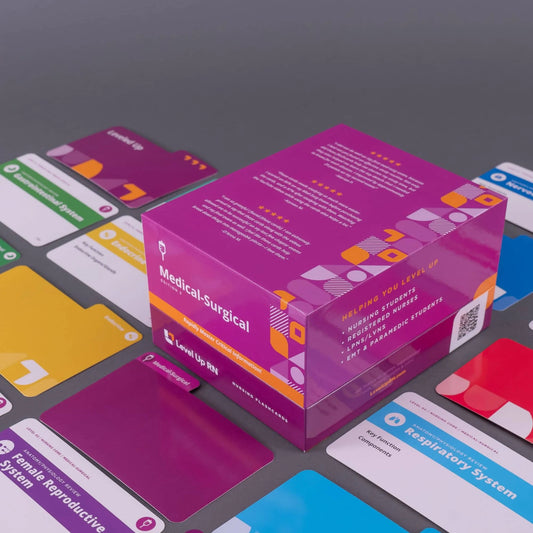In this article, we'll cover the key facts you need to know about cystic fibrosis for your Med-Surg exams and nursing practice, including signs and symptoms, labs and diagnostics, treatment, and nursing care.
The Med-Surg Nursing video series follows along with our Medical-Surgical Nursing Flashcards, which are intended to help RN and PN nursing students study for nursing school exams, including the ATI, HESI, and NCLEX.
Medical-Surgical Nursing - Flashcards
Cystic fibrosis is a genetic disorder that severely impairs lung function and causes dysfunction in other organs and tissues that make mucus or sweat.
In cystic fibrosis, autosomal recessive disorder causes obstruction of sodium transport within cell membranes, producing secretions with low water content. This results in abnormally thick, sticky mucus that plugs organ ducts of the pancreas, lungs, liver, small intestine, and reproductive organs and can lead to failure of those organs.
Signs and symptoms
The signs and symptoms of cystic fibrosis include respiratory, gastrointestinal, and integumentary effects.
Respiratory
The respiratory signs and symptoms of cystic fibrosis are wheezing, coughing, dyspnea (difficulty breathing), mucus plugs, cyanosis (blue skin), barrel-shaped chest, clubbing, and chronic respiratory infections.
Gastrointestinal
The gastrointestinal signs and symptoms of cystic fibrosis include steatorrhea, delayed growth, and fat-soluble vitamin deficiency (deficiencies in vitamins A, D, E and K).
Steatorrhea
Steatorrhea is fatty, malodorous stool. Cystic fibrosis can lead to pancreatic insufficiency, and if the pancreas cannot digest fat properly, inordinate amounts of it will remain in the stool.
Integumentary
The integumentary, or skin-related, signs and symptoms of cystic fibrosis include high sodium content in the sweat, saliva, and tears.
Labs and diagnostic tests
Labs and diagnostic tests that are available for cystic fibrosis include the sweat chloride test, DNA testing, pulmonary function tests, and a stool analysis.
Treatment
There are both pharmacological and procedural treatments for cystic fibrosis.
Medications
The medications that are available for cystic fibrosis include bronchodilators like albuterol and salmeterol, anticholinergics like ipratropium, dornase alfa (which helps to thin the secretions in the respiratory tract), antibiotics for pulmonary infections, mucolytics like acetylcysteine, and pancreatic enzymes like pancrelipase to take with meals and snacks.
These important medications are covered in our Pharmacology Flashcards for Nursing Students.
Procedure: Chest physiotherapy
Chest physiotherapy is another method available for treating cystic fibrosis. Chest physiotherapy uses percussion, vibration, postural drainage, and breathing exercises to loosen respiratory secretions. Chest physiotherapy sessions should be scheduled before meals, or 1-2 hours after meals, once food has been digested, to avoid the possibility of vomiting.
Patients should use a bronchodilator 30 minutes to 1 hour before treatment.
Nursing care
For nursing care of a patient with cystic fibrosis:
- Administer oxygen
- Encourage increased fluid intake
- Encourage a higher protein and calorie diet.
- Provide supplements, including fat-soluble vitamins A, D, E, and K.



1 comment
I love the way you explain the condition that you’re highlighting in your videos. It is easy to understand because you don’t complicate the topic, but go about explaining it in a very logical manner. Although I have already graduated nursing school, I am using your videos and lectures to review many nursing topics and it really helps me to take notes about the topic as you are explaining it. Thank you for being so thorough!